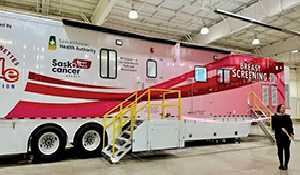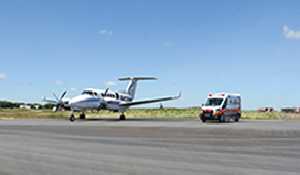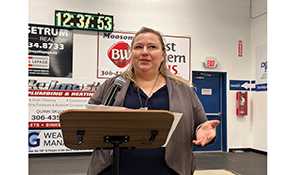Enbridge to file for Line 3 replacement
August 6, 2014, 1:46 am
Kevin Weedmark and Kristen Wee


Enbridge held an open house in Maryfield Thursday to answer questions about its Line 3 replacement project.
Line 3 has been transporting Canadian crude to the United States for almost 50 years. Enbridge announced plans last year to replace portions of the pipeline. The plan has changed since last year. Enbridge now intends to replace the pipeline across the Prairies from Hardisty, Alberta to the U.S. border—a $7.5 billion undertaking that would be the largest project in Enbridge’s history.
Some landowners at the meeting expressed concern over Enbridge’s plan to install a new pipeline and decommission the current Line 3, leaving the current pipe in the ground once it has been decommissioned and capped. The company says the decommissioning is safe, but some landowners are worried about deterioration of the pipeline in future decades.
“We have about six pipes going across a fair bit of our farm,” said Darryl Johnson of Kelso.
“Their plan is to disconnect the old pipe, put a new replacement in beside it, and we don’t want that old pipe in the ground. I’d like to see it removed completely, but they’re telling us it’ll be fine to leave it there. I’m a third generation farmer, and I’m concerned, down the road, when my next generation comes along, if there could be liability issues with this stuff and where does that leave the next generation.”
“I don’t think I’m going to see a problem with it, I think their processes are reasonable, but I’m not really excited about the way they’re going about it. And I would say that most of the people I’ve been in touch with are voicing similar concerns,” said Johnson.
“CAEPLA (Canadian Association of Energy and Pipeline Landowners Associations) is not agaist pipelines, we’re just against the way they put them in,” said Wayne DeRoo of Fairlight. “We’re not disagreeing with putting the pipe in, we just want the junk that they left there to be removed. I’m just saying we should be respected when they come in to do projects.”
“They say they’re going to cap it and fill it with an inert gas,” said DeRoo. “So how are we going to know whether it is actually working properly without that line corroding over time? I don’t expect it to happen in my lifetime, but if my son or his family are driving over that with a sprayer at 15 miles an hour, and the front wheel hits that collapsed pipe, they’re going to end up through the front window. It’s a safety thing.”
“If you’re done with it, clean it up,” said DeRoos. “That’s only respectful.”
According to Enbridge they have three reasons for leaving the pipeline in place.
“1. Removing pipelines entails major construction activities and disturbance to farmlands, neighbourhoods, roadways, wetlands, and green spaces, which we strive to avoid whenever possible. Since the decommissioned pipeline will not be removed, there will be no visible above ground changes along the right-of-way. Subject to ordinary restrictions, farming and agricultural related activities can continue on the pipeline right-of-way.”
“2. Avoiding the use of heavy equipment needed to excavate and remove the buried pipeline reduces risk to maintaining safe pipeline operation of other lines that share the right-of-way.
3. Finally, leaving a pipeline in place reduces the risk of soil stability issues that could compromise the integrity of operating pipelines that share the right-of-way.”
What does this mean for landowners and communities?
“Our decommissioning process, ongoing monitoring and federal oversight are specifically designed to protect landowners from incurring liabilities resulting from the pipe that is left in place once operation ceases. For example, in the unlikely event of pipeline related soil contamination, or other issue in the future, Enbridge will work with landowners and communities on an individual basis to respond and remediate in accordance with applicable federal and provincial environmental regulations.”
According to Enbridge, “We have a vested interest in ensuring that any decommissioned pipeline does not cause subsidence issues because these issues could compromise the integrity of the other pipelines that share the right-of-way. To prevent this from occurring we will continue to monitor and protect against corrosion by maintaining cathodic protection. Enbridge is responsible for its pipelines, whether or not those pipelines are actively operating, as well as the costs related to ongoing maintenance.”
“The biggest concern with leaving the decommissioned pipeline in the ground is getting the pipeline clean,” said Dan O’Neill with Enbridge. “We are coming up with a plan to clean the pipeline, so sending a series of brushes and squeegies through, pushed by nitrogen. Right now they’re trying to determine what the best solution is, like maybe a water solution with a detergent in it to clean the line.”
“One of the other things I’m concerned about is biosecurity,” said Johnson. They’re bringing equipment in from different areas, and nowadays there are a lot of things in agriculture that are pretty intensified. There are issues with clubroot and some noxious weeds that come from other areas that are spreading.”
“I’ve had some noxious weeds spread on one of my pieces of land about 10 years ago and they kind of danced around the subject,” said Johnson. “They didn’t outright say that it wasn’t their fault, but they didn’t come clean it up either, so I had to try to get the land back in shape. I had 13 acres that I took out of production for about 10 years, because of that biosecurity.”
O’Neill said that Enbridge takes biosecurity very seriously.
“We get a lot of people that are happy and impressed that we have a biosecurity program,” said O’Neil. “It’s quite new for us, the whole reason that we have a whole biosecurity plan is because of the new concerns that landowners are coming up to us with across the province now. Clubroot is a big one, so a lot of people are happy we have a plan and others would like to see us do more. We’re discussing with them and seeing where we can do the best job we can.”
“Biosecurity is something that we’re continuing to work on with people like Dr. Stephen Strelkov at the University of Alberta to try to figure out what the best approach to sampling is, we work with provincial governments to see what they’re doing, consult with them and consult with land owners to try to find the best approach and try to make something that’s reasonable for everybody.”
“A lot of the time we take notes when we’re talking to people,” said O’Neill. “We’re meeting with the landowners and taking notes on their concerns, both overall and in regards to their specific property, and that goes in to what we call our Consultation Log, which is part of our NEB application.”
Local farmers are also hoping for a lease payment from TransCanada for the use of their land.
“They pay for what they call an easement when they come through,” said Johnson. “It’s basically a right to access. That’s the third big thing with the Owners’ Association, is we would like to see it as a lease agreement because then down the road, say for my son, if he had a lease along that pipeline it would be more of an asset. I think that if there’s a liability issue then Enbridge doesn’t want to own or lease the land because then they’re responsible for the cleanup. My opinion is that they could evaporate like big companies do nowadays, then who’s on the hook for the mess? That stuff’s in my ground.”
“The first pipe was put in in 1950 and at that time they said that its usable lifespan was 30 years. It’s now 2014 and that makes me wonder what the real integrity of the pipeline is. I’m not going to know because I’m not allowed near it,” said Johnson.
“One of my other concerns, is that as farming evolves, we get bigger equipment and more intensified practices on the land. There has been mention in other circles, not by Enbridge specifically, but they may limit what kind of equipment you can pass over their line with,” continued Johnson.
“I’m sure we’ll work things out,” said DeRoo. “I think Enbridge has a pretty good understanding that they need to look after landowners and keep the public happy and content, and that’s the first thing we’re looking for, to keep our family and our farms viable. Safety is number one.”
The Maryfield open house is one of several Enbridge is holding in communities along the route before submitting a regulatory application, which it plans to do by the end of 2014.“We were originally planning to replace seven segments in different areas, some longer, some shorter,” said O’Neill. “At that time we were working with our customers who ship oil on the line, and we came to an agreement with them, that they’d like to see us restore the capacity of the line back to what it originally was, and replace the entire line. That’s where we’re at now and that’s why there’s been a bit of a delay in the application.”
“We did a field study that was completed in May,” said Enbridge engineer Martin Stribrny. “And we’re starting the detailed design now. We’re still negotiating the contact, it should all be put in place within a month or so. The detailed design is supposed to take until the middle of next year sometime, and then we would be doing the final drawings. There are three construction seasons, summer of 2016, winter, and summer of 2017.”
Enbridge officials say that the company takes leak detection very seriously.
“Along the pipeline there are a number of sensors that measure things like flow, pressure, temperature,density, and viscosity. If that information changes, it gets sent up to computers in Edmonton about every five seconds to the operator. We have 32 lines running out of the control centre and almost as many operators on shift 24 hours of the day, and a trained leak detector with them,” said leak detector Ron Threlfal.
“If there are any differences between what the model thinks should be going on and what the readings say, it causes a discrepancy. We monitor those and if it becomes significant we generate an alarm.”



































